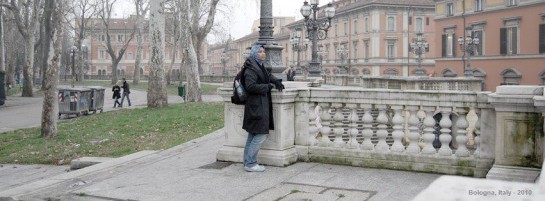sculpture
-
Art & Places: Tugu Negara, KL
Went to Tugu Negara as per suggestion of UnsungHero (UH). Thank you so much for the idea, if not for you, UH, I will be taking my own sweet time to go. Frankly, I have never visit the National Monument simply because it’s here at home.
I spent the morning to walk around the area with my son, Yassin, before sitting down to sketch the monument.

Yassin was actually lying on his stomach to be in his comfortable position to draw. Haha.
Tugu Negara (National Monument) sketch. I made one round before finding a good angle to draw. Save me the time to draw all 7 statues! Pencil and colorpencil on Moleskine Plain Notebook.The sculpture depicts a group of soldiers, with two slumped at the base and one holding the Malaysian national flag aloft. Each of the bronze figures symbolizes leadership, suffering, unity, vigilance, strength, courage and sacrifice. The granite base of the sculpture bears the old coat of arms of Malaysia, flanked on either side by inscriptions in English in Latin script and Malay in Jawi script: ‘Dedicated to the heroic fighters in the cause of peace and freedom, May the blessing of Allah be upon them.’
The monument was designed by sculptor, Felix De Weldon who was also responsible for the Marine Corps War Memorial in Virginia, United States. Completed early 1966, the sculpture stands at 15 meters (49.21 feet) tall and is the world’s tallest bronze free-standing sculpture grouping.

And here’s Yassin’s drawing:

Yassin said the monument is too hard to draw (left) so he later a soldier with gun (right).Reference: Wikipedia – National Monument (Malaysia)
- Art & Places, Frankfurt, Germany, graphite, moleskine, prismacolor, sculpture, Travel illo, TRAVEL/HOLIDAYS
Art & Places: Statue of Minerva, Romerberg, Frankfurt
Here is a statue of Minerva situated in front of timbered houses at Romerberg, Frankfurt.

Pencil and color-pencil on Moleskine plain notebook.Minerva was an ancient Roman goddess of wisdom and reason, of warfare for a good cause, protector of handicrafts, arts, schools and sciences. She was the daughter of Jupiter, the king of the gods.
Minerva was built from red sandstone by sculptor Friedrich Schierholz in 1893/94. It was half destroyed in 1944 during the WW2 and again in 1951 by the Romans. Later in 1983, sculptor Fritz Klimsch sculpted an exact copy of the statue. Minerva wears a lion head’s helmet with a crest decorated with a head of a woman (not sure what this means) and feathers.
She holds a spear on her left hand while the head of Medusa on her right. She is wearing a toga protected with an Aegis, a shield or buckler, on her body. She stands on a column decorated with floral ornaments.

Reference:
Kunst Im Offenlichen – Minerva Fountain
- Art & Places, Frankfurt, Germany, graphite, moleskine, prismacolor, sculpture, Travel illo, TRAVEL/HOLIDAYS
Art & Places: Statue of Justice, Romerberg, Frankfurt
The statue of the goddess Justitia that graces the Fountain of Justice (Gerechtigkeitsbrunnen) stands proudly at the heart of the Romerberg, Frankfurt am Main, Germany.

Pencil and color-pencil on Moleskine Plain Notebook.Previously, in 1610, the sculptor Johann Hocheisen created the fountain and the figure from red sandstone but after the war, Justitia had lost half of her arm (not sure left or right) and the scales went missing. Later in 1887, she was rebuilt in bronze by F. R. Schierholz, funded by a Frankfurt wine merchant.
Justitia, the Roman goddess of Justice, is an allegorical personification of the moral force in judicial systems. Justitia is depicted with a set of scales suspended from her right hand, upon which she measures the strengths of a case’s support and opposition. Mature, pretty and draped in flowing robes, she is also carrying a sword in her left hand, symbolizing the power of Reason and Justice, which may be wielded either for or against any party.
The statue is adorned with 4 water nymphs on the corners of its pedestal as symbol of fertility.

Reference:
Wikipedia.org – Lady Justice
Fountain of Justice
Historical Frankfurt – Fountain of Justice -
Art & Places: Welded Iron Wall Caricatures, Georgetown, Penang
I came across one of many caricatures installed around Georgetown. Since the inner city of Georgetown has been declared as World Heritage Site by UNESCO in July 2008, Penang State Tourism Development & Culture has been developing a project called ‘Marking Georgetown’ since 2009. This project consists of a total of 52 sculpture located around the city. ‘Marking Georgetown’ creatively symbolises street and social history of the early settlement days. The project showcases the works of cartoonists such as Tang Mun Kian and Baba Chuah.
Here is one that I managed to capture during my short visit to Georgetown.

Tok Tok Mee by Tang Mun Kian. Installation work was done by Scuplture at Work.Tok Tok Mee is the name of a steel-rod sculpture placed at the junction of Lebuh China and Jalan Masjid Kapitan Keling. The sculpture tells how hawkers of wantan mee signal their presence by striking ‘tok, tok’ sound. Housewives and children would be scurrying out of their homes to buy a bowl or two soon they heard the ‘tok, tok’ sound.
Reference:
http://www.visitpenang.gov.my/download2/Street-Art-Brochure.pdf
http://www.penang-traveltips.com/tok-tok-mee-sculpture.htm -
Art & Places: Jangseung, South Korea
When my husband and I visited Korean Folk Village on our last day in South Korea, these totem poles greeted us. Lucky for me, I visited National Folk Museum of Korea a day before that and knew that it is called Jangseung.

Jangseung totem poles, Korean Folk Village.
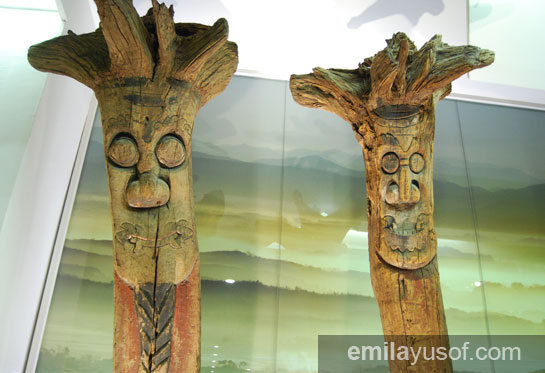
Couple Jangseung looking down at me. National Folk Museum of Korea.
Jangseung is regarded as one of the earliest examples of non-figurative art, in which a human face is carved on a wooden pole (tree trunk). Jangseung has the face of traditional Korean military officer with angry eyes, snaggle teeth and a hat on top of the pole with an inscription down at the middle. The inscription bears the meaning of ‘Great General Under Heaven’ for males, and females ‘Female General Under Earth’. These wooden totem poles, erected in groups or pairs at the entrance of Buddhist temples or villages, were worshipped as village guardians or deities with magical powers that drive out demons. Jangseung is also indicated as the border between neighbouring villages.
The history of Jangseung is dated back more than 2000 years ago. Once considered a deity, it is mostly a decorative piece now and commonly placed at the gates of large places to indicate entrances.
Jangseung is considered an organic work of art and is generally expected to last about a hundred years due to nature’s harsh elements.
I found one interesting blog post about Jangseung by Nick Elwood in his blog: A Korean Compendium. His blog post: Fascinating Physogs – A Tour of Some Korean Totem Poles explores the many types of Jangseung. Go read it.
-
Art & Places: Fontana del Pincio, Montagnola Park, Bologna, Italy
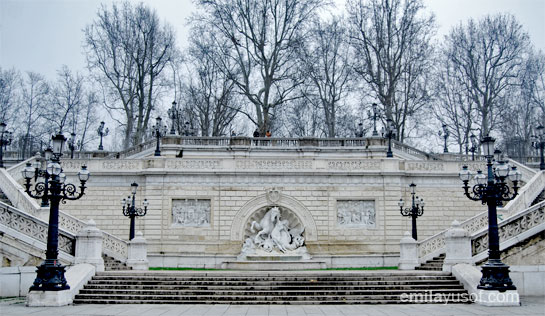
When I walked aimlessly along Via Dell’ Iindependenza from the Bologna Centrale (after I got myself lost in Firenze), I saw this beautiful steps with a fountain that leads to a park. I did not know what park it was because I just went where my feet took me. Only after I went home, I learned about the name of the park: Montagnola Park or Parco della Montagnola. The fountain is called Fontana del Pincio.
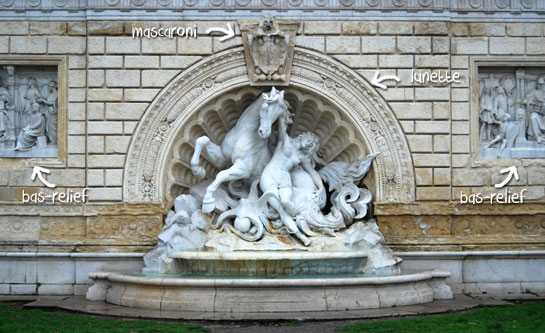
The fountain depicts a nymph on the back of a sea horse, both struggling against the embrace of an octopus in a big seashell. These elements are positioned in a lunette (semi-circle shaped space) with floral motifs. On the centre of the lunette, there is a mascaroni, or decorative keystone of a lion holding two shields that merged into one, which is actually Bologna’s state emblem. The lion’s head depicts a lion donated by Marquis Obizzo d’Este to the commune in 1293.
Looking at the sea nymph and the seashell, it reminded me of Boticelli’s painting ‘Birth of Venus’, you know the one standing on a seashell with no clothes on just her hair covering her private part. The elements of nymph, horse, seashell were among mythical elements commonly used during Early Florentine Renaissance period.
The fountain was sculpted by Diego Sarti and Pietro Veronesi in 1896, both were masters graduated from Academy of Fine Arts, Bologna. They also sculpted two bas-reliefs on both sides of the sculpture dedicated to the University of Bologna (Colombarini) and the free city (Sabbioni). The impressive staircase access to Montagnola Park was designed by Tito Azzolini and Attilio Muggia in 1892. The steps of the Pincio is equipped with 72 metal candelabra with six or four lamps.
Me standing at Parco Della Montagnola. Self-portrait, Nikon D40X with the help of a tripod and wireless remote control. Bologna, Marzo 2010
Information credit: http://www.bibliotecasalaborsa.it, http://en.wikipedia.org/wiki/Bologna
-
Art & Places: Vittorio Emanuele II Monument, Venice, Italy
When I visited Venice, I saw this one huge monument and it says “I. MAGGIO MDCCCLXXXVII”. I can only read the last 6 Roman numbers (37) but not sure about the rest. So, I Google-d.
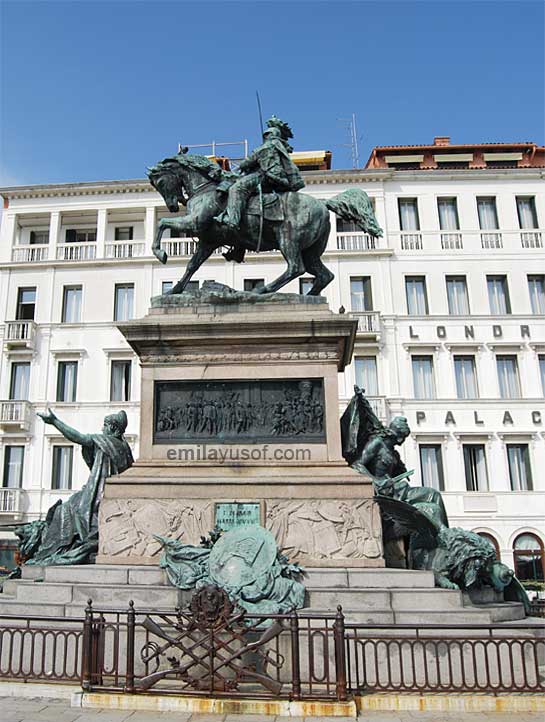
From my research on the Internet, in Roman numerals, MDCCCL means M=1000, D=500, C=100 (CCC = 100 x 3); L=50. It sums up to 1850. 1850 + 37 = 1887. So, the Roman letterings I.Maggio MDCCCLXXXVII means 1 May 1887. Must be a year of significant for Venice, or Italy in general.
So what happened in May 1887? And why does a monument bears the date?
Well, a lot of things happened in Italy in May 1887 and one that relates to the statue was an inauguration date. The monument above was inaugurated in May 1st, 1887. The monument was made to honour Vittorio Emmanuele II, the first king of a United Italy. It is located on the Riva degli Schiavoni waterfront in the Castello district of Venice (Venezia), Italy. There are several of them in other cities in Italy.
The bronze equestrian monument is 125 years old and was sculpted by Ettore Ferrari. Ferrari was born to an artistic family. He was a professor at the Accademia di San Luca, a deputy in the Italian Parliament and Grand Master of the Grande Oriente d’Italia. He sculpted many other statues around Italy.
Now, knowing a history behind a monument or statue, or better known as public art, is more significant. Although I could not gather the information during my visit to Venice, I am glad I took pictures and made the effort to find the history of this monument. Here are more pictures of the monument.
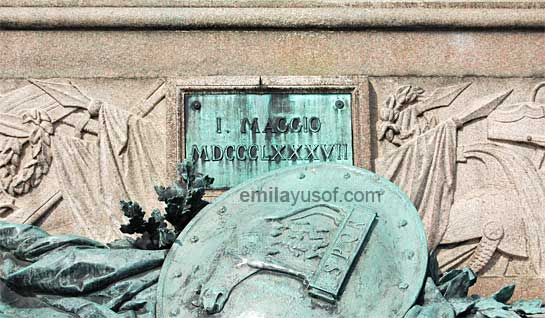

Credit: most informations are from Wikipedia.org.
